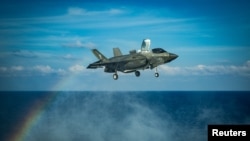Three aircraft carriers have sailed the South China Sea this week, an unusually big show of force in the disputed Asian waterway and likely a warning to Beijing. China is all but sure to respond with its own show of force, yet neither side is expected to fire a shot.
China hopes to answer each U.S. military action in at least matching form to prove extra strength in a U.S. election year, impress smaller countries in Asia and jazz up its own population, political analysts say.
“The current Chinese policy is if (the) U.S. does something, we need to respond in proportion at the same level of intensity and at the same level of seriousness,” said Yun Sun, East Asia Program senior associate at the Stimson Center research organization in Washington.
The USS Theodore Roosevelt, USS Nimitz and USS Ronald Reagan aircraft carrier groups had entered the South China Sea in late June, U.S. Indo-Pacific Command says.
The Nimitz and Ronald Reagan groups were to hold “integrated exercises and operations that maintain responsive, flexible, and enduring commitments to mutual defense agreements with allies and partners in the Indo-Pacific,” U.S. Indo-Pacific Command said in a June 29 statement.
China will answer in kind – militarily, politically or diplomatically – in part because it knows U.S. President Donald Trump might leave office after elections in November, Sun said.
More than two years of trade disputes, differences over the future of the Chinese territory Hong Kong and growing U.S. support for Taiwan have put China on guard against Trump. Taiwan is self-ruled, but China calls the island its own.
“China might believe that it has nothing to lose during the rest of the Trump Administration and may as well use this opportunity to resolve all the difficult issues Beijing had always wanted to do but were not able to do (and) now is a good time,” Sun said.
Officials in Beijing last month passed a security law aimed at stopping protests in Hong Kong, to Washington's chagrin, and battled Indian troops over a separate territorial dispute with Washington's ally New Delhi.
The Communist leadership in Beijing would respond to the U.S. aircraft carriers to remind the world of its influence in Asia, especially the South China Sea, said Oh Ei Sun, senior fellow with the Singapore Institute of International Affairs. He likened that ambition to the 1823 Monroe Doctrine, a U.S. policy saying European powers should keep out of the Americas and vice versa.
“China would consider this part of the world, the regions around South China Sea, to be its sphere of influence,” Oh said. “This is perhaps akin to the Monroe Doctrine, that European powers should not interfere in the Americas, and so on.”
Beijing is the militarily strongest claimant to the South China Sea, a 3.5 million-square-kilometer waterway prized for fish and energy reserves. Brunei, Malaysia, the Philippines, Taiwan and Vietnam vie with China over all or part of its claim to about 90% of the sea.
Washington says the sea should stay open internationally. Under Trump, the U.S. government has helped Vietnam, Taiwan and the Philippines buck up their armed forces.
Chinese officials "obviously don’t welcome all these U.S. warships to pass by,” Oh said.
Chinese military experts believe U.S. aircraft carrier movement reveals “hegemonic politics in the region”, Beijing-based, state-controlled news outlet Global Times reported June 14. “China could counter it by holding military drills and showing its ability and determination to safeguard its territorial integrity,” the news website said.
China has shown this resolve to match U.S. naval activity in Asia already. Previous exchanges chilled Sino-U.S. relations and deterred smaller Asian countries from taking sides but never sparked conflict.
U.S. warship passages through a strait separating Taiwan from China have met since 2017 with frequent Chinese air force flights into Taiwanese airspace, for example. After the guided-missile destroyer USS Barry passed near Chinese holdings in the South China Sea in April, Beijing renamed 80 islets and submerged features in its favor.
China expects its responses against the United States to raise Chinese people’s confidence in the People’s Liberation Army, said Alexander Huang, strategic studies professor at Tamkang University in Taiwan. The government hopes to show its people it can meet the United States “eye to eye”, he said.
The 100th anniversary of the Communist Party’s founding next year will strengthen its urge to resist U.S. influence, Huang said. The single-party government normally tries to appear strong ahead of major events.
“I think in the coming months, they will probably have to show their strength,” he said. “There is no way to back off at this moment.”




